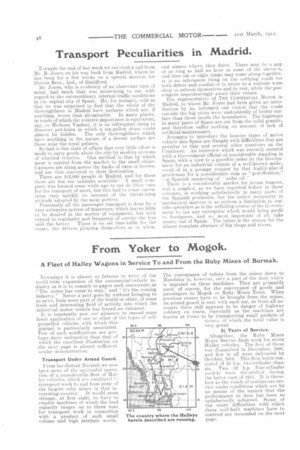Transport Peculiarities in Madrid.
Page 4

If you've noticed an error in this article please click here to report it so we can fix it.
Towards; the end of last week we received a call from B. Jones on his way hack from Madrid, where he has been for a few weeks on a special mission for Dennis Bros., Ltd., of Guildford.
Mr. Jones, who is evidently of an observant turn cf mind, had much that was interesting to say with regard to the extraordinary internal traffic conditions in the capital city of Spain. He, for instance, told us that he was surprised to find that the whole of the thoroughfares in Madrid have surfaces which are, if anything, worse than abominable. In many places, in roads of which the relative importance is equivalent, say, to Holborn Viaduct, it is no infrequent thing to discover pot-holes in which a six-gallon drum could .almost be hidden. The only thoroughfares which have anything in the nature of a decent surface are those near the royal palaces.
So bad is this state of affairs that very little effort is made to carry goods about the city by modern systems • of wheeled vehicles. One method is that by which xneat is carried.frotn the market to the small shops.
• Carcases are slung across the backs of oxen or horses, and are thus conveyed to their destination.
There are 512,000 people in Madrid, and for these there are but ten taxicabs available A small com pany was formed some while ago to use de Dion vans for the transport of meat, but this had to cease Operations very quickly on account of the threatening ati itude adopted by the meat, porters.
Practically all the passenger transport is done by a very extensive system of tramways, which leaves little
to be desired in the matter of equipment. but with regard to regularity and frequency of service the less said the better. There is no set time-table for the -tram,., the drivers pleasing themselves as to when,
and almost where, they drive. There may be a gap of as long as halt an hour in some of the services, and then six or eight trams may come along together. Lt is no infrequent thing on the outlying roads for both driver and conducLor to retire to a wayside wine shop to refresh themselves and to rest, while the passengers unprotestingly await their return.
The representative of THE COMMERCIAL MOTOR in Madrid, to whom Mr. Jones had been given an introduction by us, informed our visitor that the roads outside the big cities were undoubtedly of better surface than those inside the boundaries. The highways in many parts of Spain are cut, from the solid granite, and therefore suffer nothing on account of lack of artificial maintenance.
Attempts to introduce the heavier types of motor vehicle into Spain are fraught with difficulties that are peculiar to that and several other countries on the Continent. An interview which was recently secured with a Government official of considerable standing in Spain, with a view to a possible order by the Government for an industrial vehicle of a well-known make, resulted in a prompt request by that highly-placed gentleman for a considerable sum as "gratification," —a Spanish rendering of " palm oil."
There is a considerable market for steam wagons, and a number, as we have reported before in these eolumns, is working satisfactorily in many parts of the Spanish peninsula, but the native incapacity in mechanical matters is as serious a limitation to outside operation as is the unfailing course of the Gevernment to tax any enterprise which would bring profit to foreigners. and so, most important of all, take money out of Spain. The latter is the reason for the almost complete absence of big shops and stores.




















